
body fluids and circulation notes for class 11 biology download in pdf, pulmonary circulation, systemic circulation, circulation biology, circulation problems, how to increase circulation, circulation problem, circulation in biology, system circulation, oxygen circulation, what is circulation in biology, supplements for circulation, increase circulation, circulation medication, increasing circulation, circulation supplements, boost circulation, better circulation, circulation doctor, help circul, body fluids and circulation 11 notes, class 11 biology notes, body fluids and circulation class 11, body fluids and circulation class 11 notes, class 11 body fluids and circulation, note biology, biology notes, body fluids and circulation, class 11 cbiology chapter 18 notes, 11th standard
Blood : A special connective tissue that circulates in principal vascular system of man
and other vertebrates consisting of fluid matrix, plasma and formed elements.
Plasma : The liquid part of blood or lymph which is straw coloured, viscous fluid and
contains about 90-92% of water and 6-8% proteins.
Lymph : A clear yellowish, slightly alkaline, coagulable fluid, containing white blood
cells in a liquid resembling blood plasma.
Hear Beat : The rhythmic contraction and relaxation of the heart, which includes
one systole (contraction phase) and one diastole (relaxation phase) of the heart. Heart
beat count of healthy person is 72 times per minute.
Cardiac output : The amount of blood pumped by heart per minute is called
cardiac or heart output. The value of cardiac output of a normal personis about 72×70
= 5040 mL or about 5L per minute.
Electrocardiograph : (ECG) The machine used to record electrocardiogram.
Electrocardigoram ECG : The graphic record of the electric current produced by
the excitation of the cardiac muscles. It is composed of a ‘P’ wave, ‘QRS’ wave
(complex) and ‘T’ wave (Refer fig. 18.3, page 286 (for a standard ECG) (NCERT
class XI - Biology)
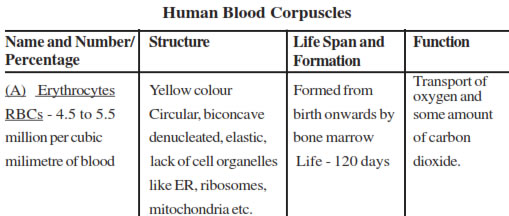
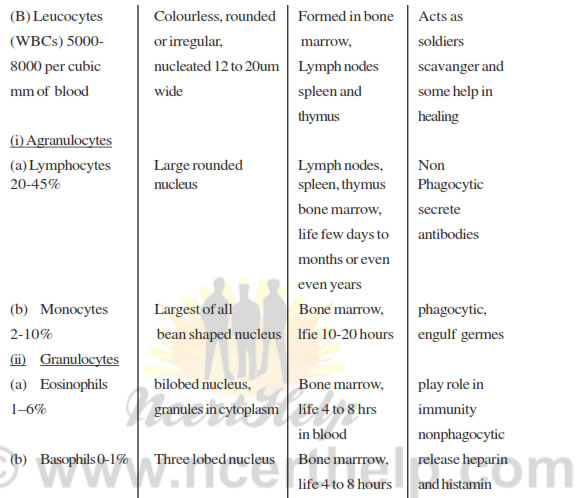
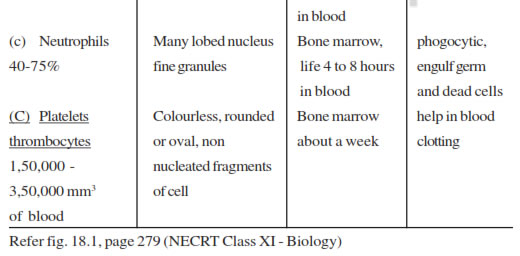
The colouless mobile fluid connective tissue drains into the lymspatic capillaries
from the intercellular spaces.
Composition : It is composed of fluid matrix, plasma, white blood corpuscles or leucocytes.
Functions :
(i) It drains excess tissue fluid from extra celluar spaces back into the blood.
(ii) It contain lymphocytes and antibodies.
(iii) It transport digested fats.
It is the mesodirmally derived organ situated in thoracic cavity in between the
two lungs. Protected by pericardium.
•
Four chambers - two (left and right) atria, and two ventricles (left and right)
•Inner- artrial septum separates the two atria and inter ventricular septum
separates th two ventricles, while the atria & ventricles are separated by atrioventricular
septum.
•
The valves between right atrium and right ventricle is tricuspid while between
left atrium and ventricle is bicuspid or mitral value.
•
The openings of the right and the left ventricles into the pulmonary artery and
the aorta are guarded by semilunar values.
•
The values allow the flow of blood only in one direction, i.e., from atria to
ventricles and from ventricles to pulmonary artery or aorta.
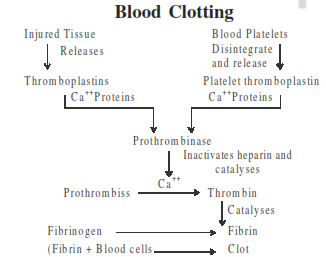
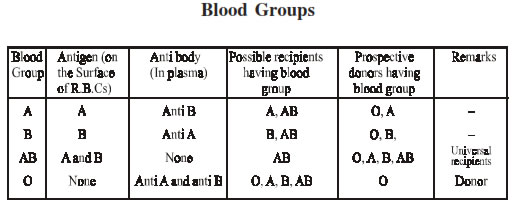
Rh (Rhesus) System :
Discovered by Landsteiner and wiener in 1940. The antigen found on the surface
of RBCs. The presence of this antigen is termed as Rh - positive (Rh
) and its absence
as (Rh
–
+
)
♦
SAN (Sino - artrial node) : A patch of tissues present in the right upper corner
of the right atrium.
♦
AVN (Atrio Ventricular Node) : A mass of tissues seen in the lower left
corner of the right atrium close to the atrio-ventricular septum.
Tricuspid Valve : The valves formed of three musclar flaps or cups, which guard the
opeing between the right atrium and the right ventricle.
Bicuspid Valve (Mirtral Valve) : The valves which guard the opeing between the left atrium and the left ventricle,
made up of two flaps.
Semilunar Valves : The valves present at the opeing of the right and the left
ventricles and allow the entry of blood into pulmonary artery and the aorta respectively.
Reading of ECG : ‘P’ Wave represents the electrical excitation (or depolarisation)
of the atria and leads to the contraction of both the atria.
‘ORS’ complex : represents the depolarisation of the ventricles, which imitiates the
ventricular contraction
‘T’ Wave : represents the return of the ventricles from excited to normal state
(repolarisation). The end of T-wave marks the end of sytole.
Double circulation : The passage of same blood twice throught heart in order to
complete one cycle. eg.
(i) The blood pumped by the right ventricle (dioxygenated blood) is trans ported
through pulmonary artery to lungs where CO
2
is exchanged with O
through
diffusion and returns back to the heart through pulmonary vein.
(ii) The oxygenated blood from left ventricle is trans ported through aorta to different
body parts (cells and tissues) where O
2
is exchanged with CO
through deffusion
and then returned back to the heart through vena-cava.
Disorders of circulatory System
2
Hypertension
(High Blood Pressure) : It results from narrowing of arterial
lumen and reduced elasticity of arterial walls in old age. It can cause rupturing of
capillaries. It is a silent killer.
Coronary Artery Disease : (CAD) Atherosclerosis The supply of the blood
to heart muscles is affected. It is caused by deposits of ca, fat, cholesterol and fibrous
tissues to make the lumen of arteries narrower.
Angina Pectoris : Caused due to arteriosclerosis, when no enought oxygen is
reaching the heart muscle due to which the perosn experiences acute chest paind.
Heart attack : Caused when the heart muscle is suddenly damaged by an
inadequate blood supply.
Cardiac arrest : The state in which the heart stops beating.
Arteriosclerosis : The state of hardening of arteries and arterioles due to
thickening of the fibrous tissue and consequent loss of elasticity. It Causes
hypertension.
Copyright @ ncerthelp.com A free educational website for CBSE, ICSE and UP board.